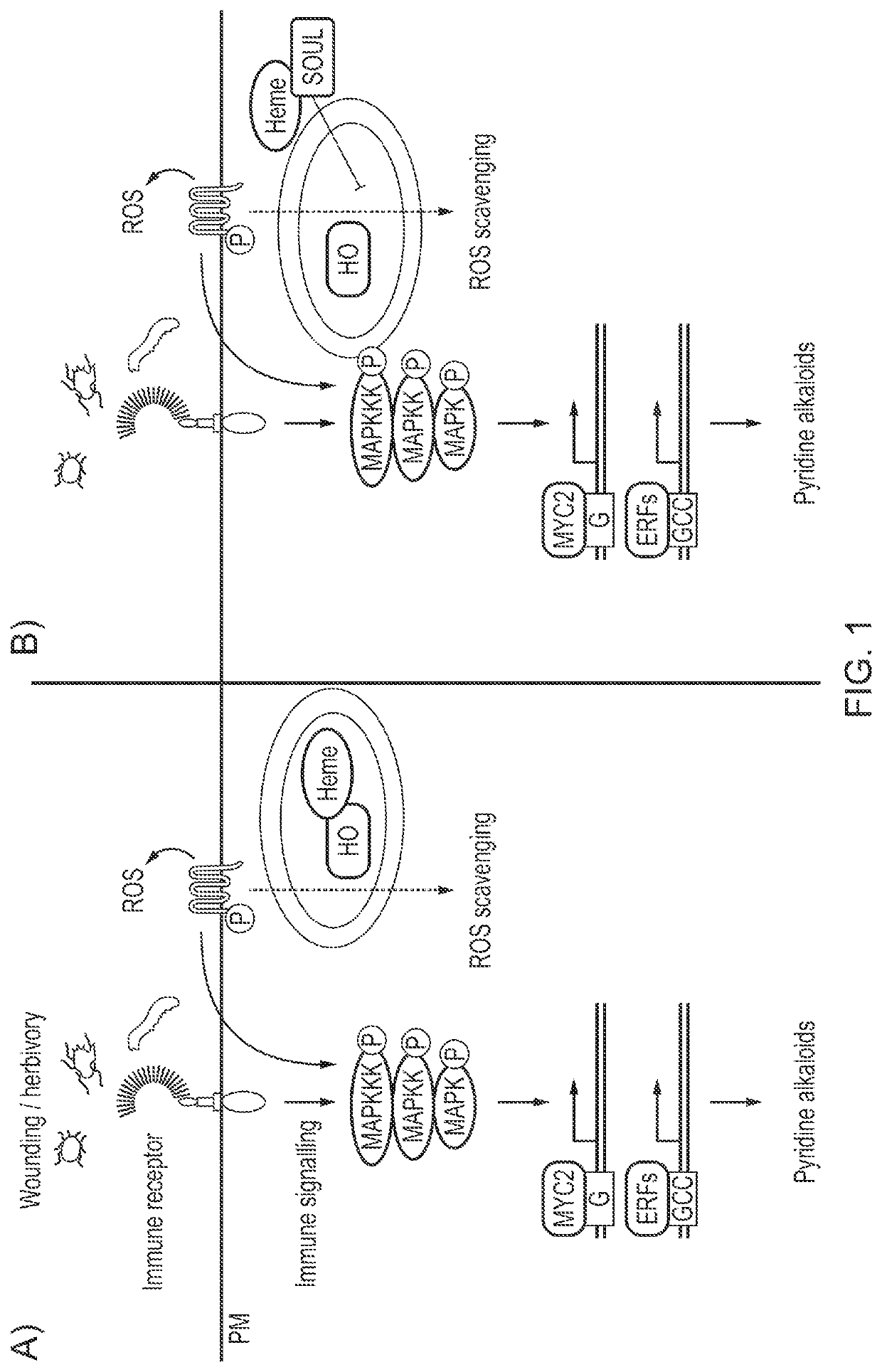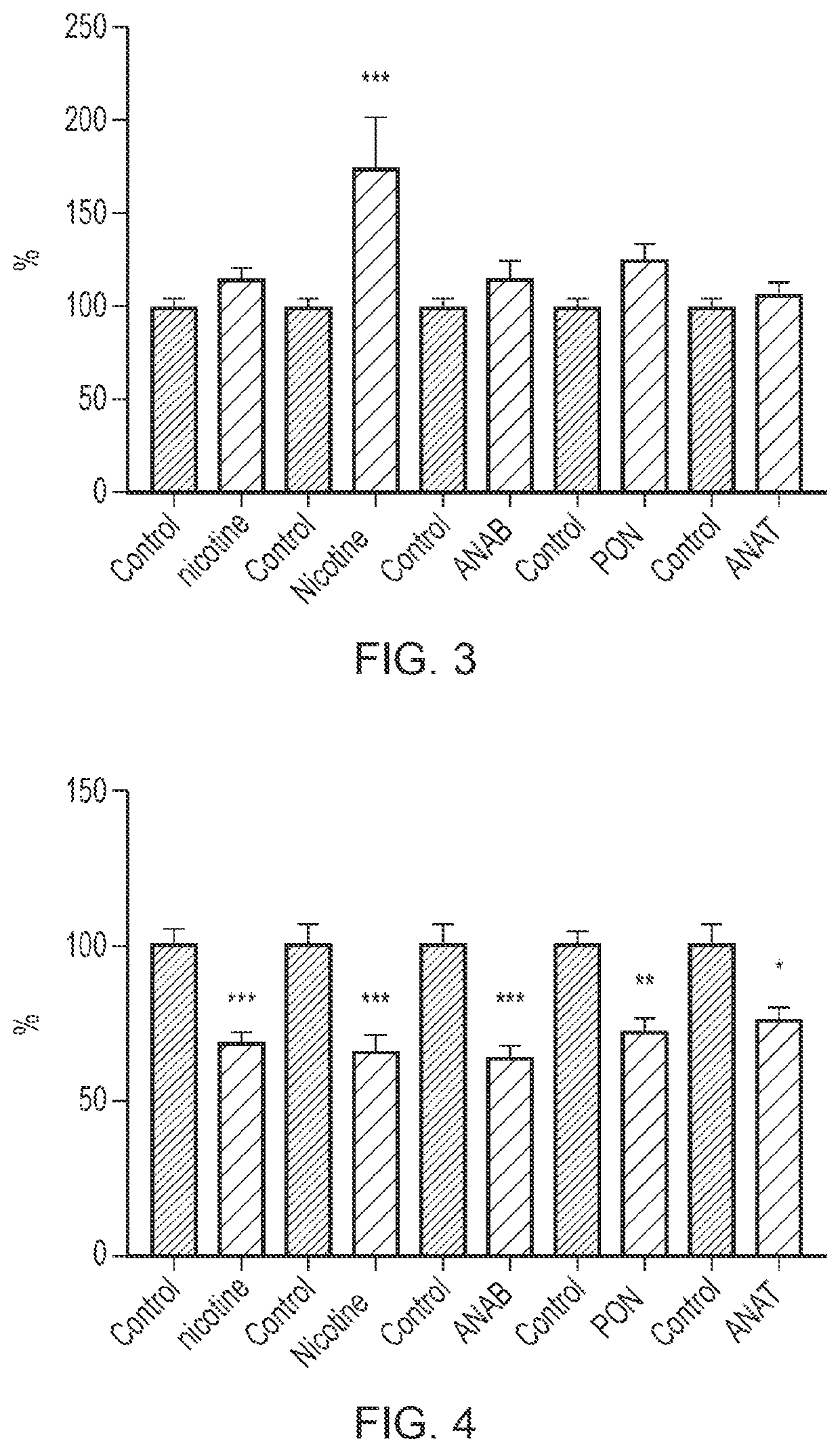Method for decreasing the alkaloid content of a tobacco plant
a tobacco plant and alkaloid content technology, applied in tobacco treatment, biochemistry apparatus and processes, tobacco, etc., can solve the problems of nnn level drop, no enzymes or genes responsible for producing pon have been identified so far, etc., to increase activity or expression, increase alkaloid content, and increase activity or expression
- Summary
- Abstract
- Description
- Claims
- Application Information
AI Technical Summary
Benefits of technology
Problems solved by technology
Method used
Image
Examples
example 1
Overexpression of a SOUL Haem-Binding Protein Increases Alkaloid Content in Leaves
[0599]Methods and Materials
[0600]Cloning
[0601]SOUL Haem-Binding Protein Expression Vector
[0602]The SOUL haem-binding protein gene sequence (SEQ ID No. 3) was amplified from a Gateway™ compatible cDNA library using primers located outside restriction sites flanking the gene sequence. The gene sequence was then transferred to an expression vector, depicted in FIG. 2.
[0603]The resulting plasmid was sequenced and transformed into Agrobacterium tumefaciens GV3101pMP90 by heat shock and transiently expressed in TN90 leaves.
[0604]Transient Gene Expression
[0605]Agrobacterium tumefaciens GV3101 strains carrying the construct of interest were grown overnight in Luria-Bertani (LB) medium supplemented with appropriate antibiotics. Cultures were spun down and re-suspended in buffer containing 10 mM MgCl2, 10 mM MES pH 5.6 and 100 μM acetosyringone to OD600=0.6 and incubated for one hour at room temperature.
[0606]In...
example 2
uced Gene Silencing (VIGS) of a SOUL Haem-Binding Protein Decreases Alkaloid Content in Leaves
[0618]Virus-Induced Gene Silencing (VIGS)
[0619]For virus induced gene silencing, a 300-nucleotide cDNA fragment (SEQ ID No. 25) was synthesized and cloned with In-Fusion cloning kit into pTV00. The plasmid was then transformed into A. tumefaciens GV3101.
[0620]The TRV vector comprising both TRV RNA1 (SEQ ID No. 26) and TRV RNA2 (SEQ ID No. 27) comprising the targeted nucleotide sequence were separately propagated in A. tumefaciens. These cultures were mixed (1:1) and syringe-infiltrated into 2-week-old TN90 plants. The silencing effect was assessed five weeks post-virus infection by assessing the expression level of the target gene.
[0621]Silencing
[0622]VIGS assays were performed as previously described (Ratcliff et al. (2001) The Plant Journal 25: 237-245, incorporated herein by reference). Briefly, independent cultures of A. tumefaciens GV3101 carrying TRV2 and TRV1 plasmids were propagated...
example 3
Testing
[0628]The effects of the homologues of SEQ ID No. 1, namely SEQ ID Nos 4, 7, 10, 13, 16, 19 or 22 are tested in transient assays as described in Example 2.
[0629]The transient expression of SOUL haem-binding binding protein expression vectors for homologues SEQ ID Nos 4, 7, 10, 13, 16, 19 and 22 are shown in FIG. 33.
[0630]Transient overexpression of all tested homologues led to a significant increase in nornicotine content.
PUM
| Property | Measurement | Unit |
|---|---|---|
| Fraction | aaaaa | aaaaa |
| Content | aaaaa | aaaaa |
| Combustion | aaaaa | aaaaa |
Abstract
Description
Claims
Application Information
 Login to View More
Login to View More - R&D
- Intellectual Property
- Life Sciences
- Materials
- Tech Scout
- Unparalleled Data Quality
- Higher Quality Content
- 60% Fewer Hallucinations
Browse by: Latest US Patents, China's latest patents, Technical Efficacy Thesaurus, Application Domain, Technology Topic, Popular Technical Reports.
© 2025 PatSnap. All rights reserved.Legal|Privacy policy|Modern Slavery Act Transparency Statement|Sitemap|About US| Contact US: help@patsnap.com



